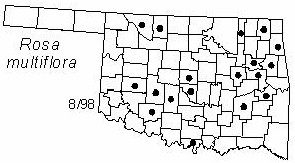Climbing vine or erect shrub to 5 m (15 ft) tall. Twigs red to green, glabrous; prickles stout and recurved. Leaves alternate, pinnately compound, with 5-11 leaflets (typically 9); leaflets ovate or elliptic, 2.5-4 cm (1-1.6 in) long and 1.3-2.3 cm (0.5-0.9 in) wide, cuneate base; rounded or acute apex; margins serrate; petiole broad-based, pubescent, 1-1.3 cm (0.4-0.6 in) long; stipule tips acuminate, spreading, margins with deep linear lobes; rachis pubescent. Inflorescence a rounded panicle, pedicels long and pubescent, with 6-30 flowers; calyx 5-lobed, oval with entire margins; 5 petals, pink to white, obovate; styles curved, green-white; stamens numerous; flowers appear in late May. Fruit hips in drooping clusters, oval to obovoid, 6-8 mm in diameter, calyx deciduous; nutlets yellow, ovoid, 4-4.5 mm (about 0.15 in) long, flattened on two sides; fruits mature in September.
Distribution: Native to east Asia, but naturalized over most of the eastern U. S.
Habitat: roadsides, fence rows, abandoned homesteads.
Comment: Rosa is the classical name for roses; multiflora refers to the profuse flowering clusters. Multiflora rose has been widely planted as an ornamental and for wildlife cover. It has escaped from cultivation and is considered a nuisance in many parts of the country. It may persist for many years.
Field identification: This plant can be readily identified by the many flowers it produces. Also, the ragged or fringed appearance of the stipules is unique.
Wildlife benefits: Multiflora rose is planted for wildlife cover. Although few animals eat the fruits of multiflora rose, it is dispersed by birds.
NWI status: UPL, FACU.
Distribution in Oklahoma: 
BACK
NEXT
RETURN TO INDEX
Last update: 9/17/99
 Go to Oklahoma Biological Survey Home Page
Go to Oklahoma Biological Survey Home Page
 Disclaimer
Disclaimer